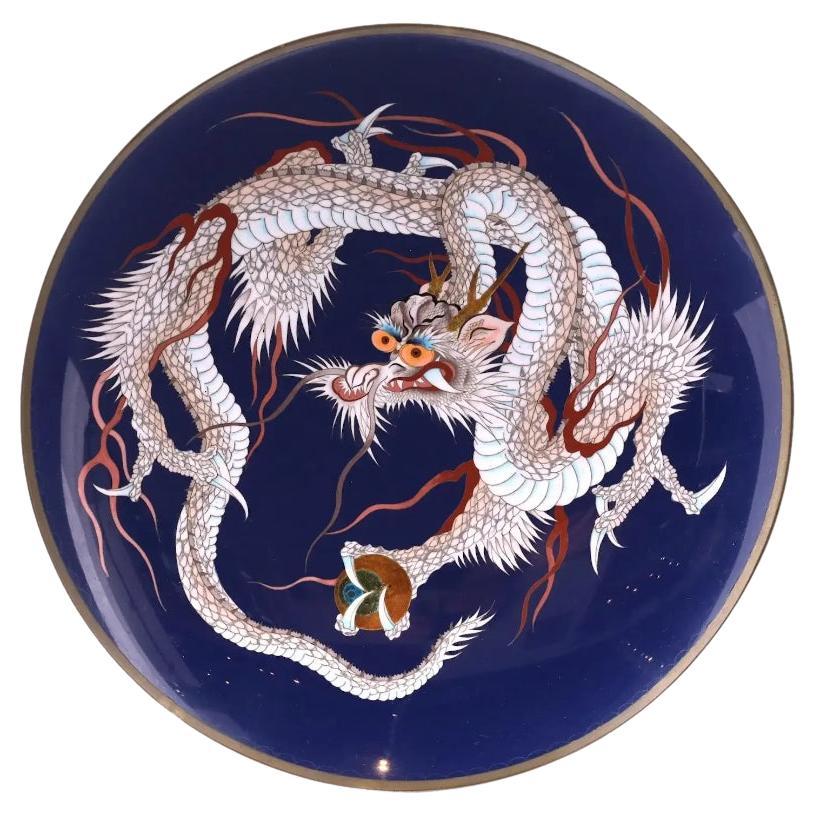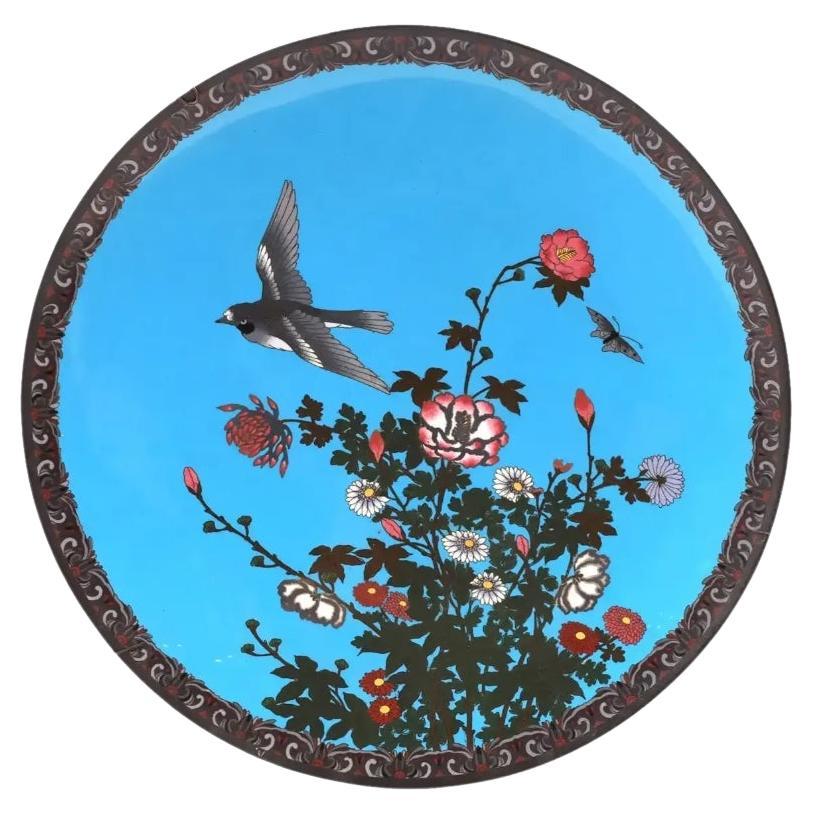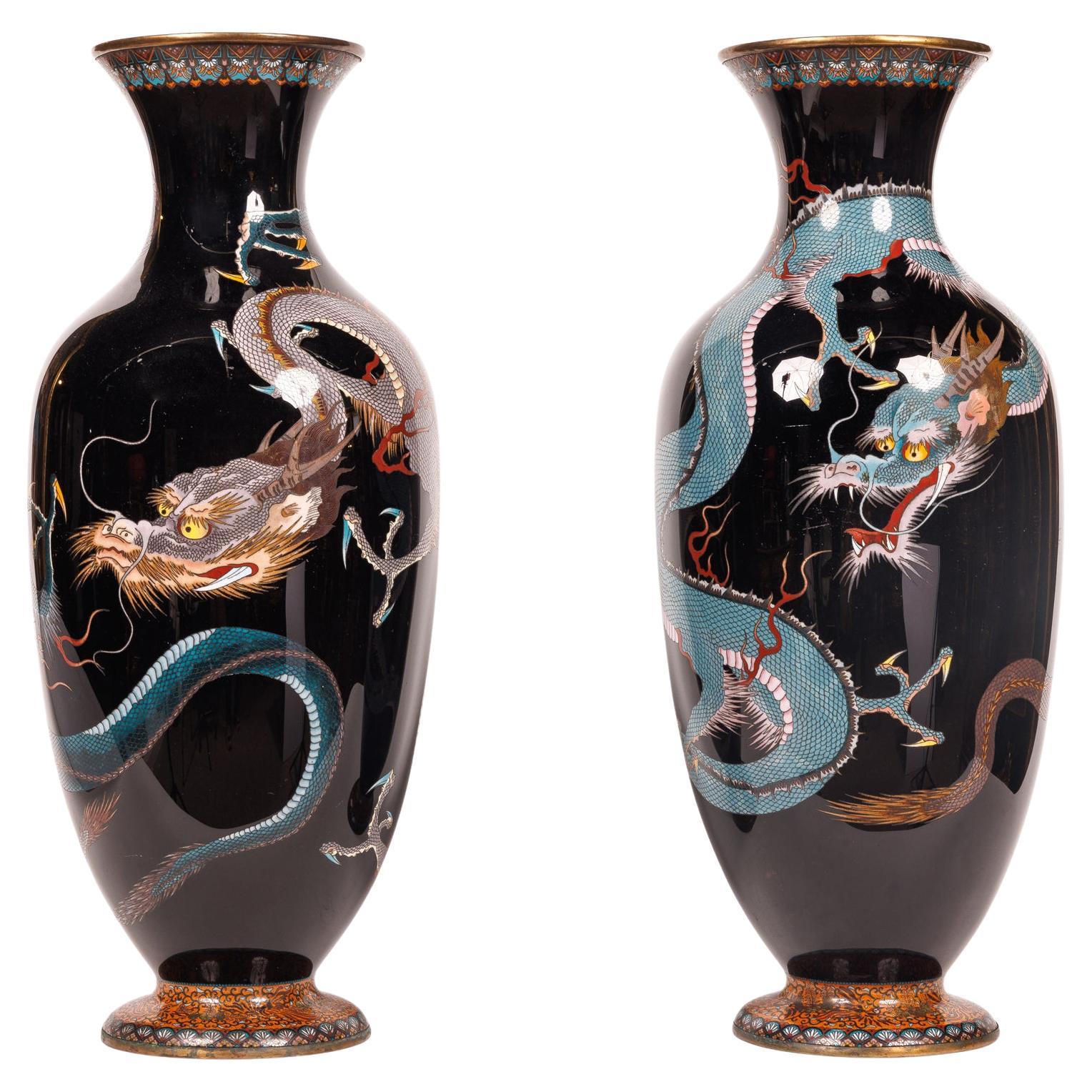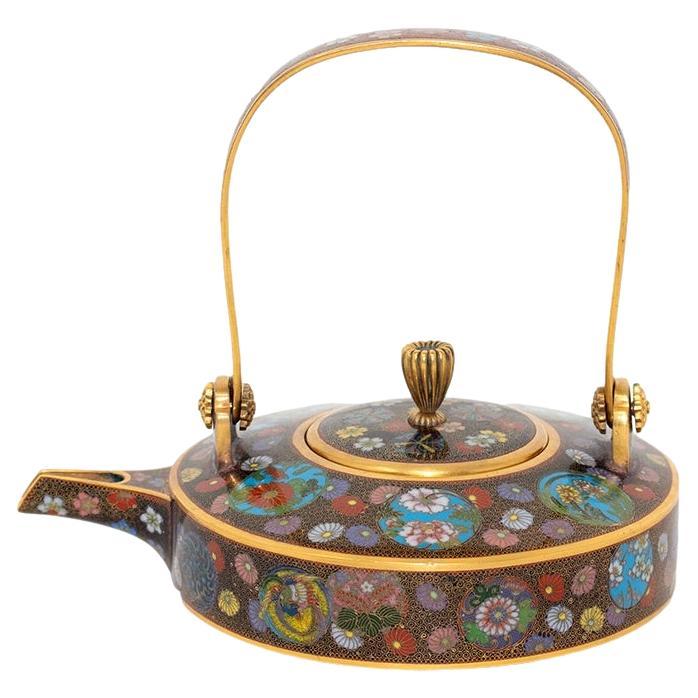Items Similar to Japan 1900 Meiji Period Charger With A Dragon In Cloisonné Multicolor Enamel
Want more images or videos?
Request additional images or videos from the seller
1 of 9
Japan 1900 Meiji Period Charger With A Dragon In Cloisonné Multicolor Enamel
About the Item
Large charger in cloisonné from imperial Japan.
Beautiful piece of Japanese decorative arts, created during the Meiji imperial period, circa 1900. Crafted in solid bronze with copper wires and cloisonné color enamels. The predominant colors are blue and black, with the mythological orientalist figure of a flying dragon, surrounded by multiples geometrical figures and abstractions of the chrysanthemum flowers.
Meiji period
This Japanese era extended from October 23, 1868 to July 30, 1912.The Meiji era was the first half of the Empire of Japan, when the Japanese people moved from being an isolated feudal society at risk of colonization by Western powers to the new paradigm of a modern, industrialized nation state and emergent great power, influenced by Western scientific, technological, philosophical, political, legal, and aesthetic ideas. As a result of such wholesale adoption of radically different ideas, the changes to Japan were profound, and affected its social structure, internal politics, economy, military, and foreign relations. The period corresponded to the reign of Emperor Meiji. It was preceded by the Keiō era and was succeeded by the Taishō era, upon the accession of Emperor Taishō.
Cloisonné
This is an enameling technique in which the pattern is formed by wires soldered to the surface of the object to be decorated, which is usually made from copper, forming cells or cloisons, each of which holds a single colour of enamel paste which is then fired, and ground and polished. The champlevé technique also uses an enameling technique, but the cells are formed by carving into the surface of the object, or in the casting. The cloisonné technique has been in use since the 12th century BC in the west, but the technique did not reach China until the 13th or 14th century. It became popular in China in the 18th century. Initially bronze or brass bodies were used, and in the 19th century copper, at which time the quality of the items produced began to decline. Chinese cloisonné is the best known enamel cloisonné, though the Japanese produced large quantities from the mid-19th century, of very high technical quality. In the west the cloisonné technique was revived in the mid 19th century following imports from China, and its use continued in the Art Nouveau and Art Deco periods.
Measurements: Have a diameter of 300 mm (11.81 Inches) and raise 38.1 mm (1.50 Inches) over the base.
Condition: The overall condition of this piece is excellent. Beside the little normal wear, there is no damage to the bronze. The cloisonné parts are secured in the settings. This piece has been carefully inspected to guarantee the condition and authenticity.
INVENTORY REF: D091923SNMY/.6723
- Dimensions:Height: 1.5 in (3.81 cm)Diameter: 11.81 in (30 cm)
- Style:Meiji (Of the Period)
- Materials and Techniques:
- Place of Origin:
- Period:1900-1909
- Date of Manufacture:1900
- Condition:Wear consistent with age and use. The overall condition of this piece is excellent. Beside the little normal wear, there is no damage to the bronze. The cloisonné parts are secured in the settings. This piece has been carefully inspected to guarantee the condition and authenticity.
- Seller Location:Miami, FL
- Reference Number:
About the Seller
5.0
Platinum Seller
These expertly vetted sellers are 1stDibs' most experienced sellers and are rated highest by our customers.
1stDibs seller since 2023
63 sales on 1stDibs
Typical response time: <1 hour
- ShippingRetrieving quote...Ships From: Miami, FL
- Return PolicyA return for this item may be initiated within 1 day of delivery.
More From This SellerView All
- Japan 1890 Meiji Period Decorative Vase In Cloisonné Enamel With Wood BaseLocated in Miami, FLJapanese vase from the Meiji Period (1868-1912). Beautiful antique decorative vase, created in Japan during the Meiji period (1868-1912), circa 1890s. It was carefully crafted in so...Category
Antique 1890s Japanese Meiji Metalwork
MaterialsBronze, Enamel
- Japan 1890 Meiji Period Bronze Koro Censer in Cloisonne Enamel with Jade LidLocated in Miami, FLJapanese Koro from the Meiji Period (1868-1912). Beautiful antique ten sides fluted koro censer, created in Japan during the Meiji period (1868-1912), ci...Category
Antique 1890s Japanese Meiji Metalwork
MaterialsJade, Gold, Silver, Bronze, Enamel
- Ota Jinnoei 1890 Imperial Meiji Period Pair of Cloisonne Cabinet VasesBy Ota JinnoeiLocated in Miami, FLPair of cloisonne vases designed by Ota Jinnoei. Beautiful pair of small cabinet vases, created in Japan circa 1890, during the meiji Imperial period (1868-1912). These vases has ...Category
Antique 1890s Japanese Meiji Metalwork
MaterialsSilver, Bronze, Enamel
- Japan Meiji 1900 Three Bronze Ducks Sculpture in Wood Stand and CoralLocated in Miami, FLSculptural composition of the ducks from the Japanese Meiji Period. Beautiful and very well realized sculptural composition of three ducks, made during the japanese imperial perio...Category
Antique Early 1900s Japanese Meiji Sculptures and Carvings
MaterialsCoral, Bronze
- China 960 Ad Song Dynasty Very Rare Imperial Period Offering Vessel in BronzeLocated in Miami, FLOffering vessel from the Chinese Song Dynasty (960/1279 AD ). A beautiful "offering spiritual vessel" from the Yunnan province region in the ancient China. This rare vessel was created in red bronze during the Song Dynasty period. between 960/1279 AD. This is one of the most unusual forms of red bronze jar. A large vessel, the sides are virtually perpendicular to the base. The stepped lid design is also among the more rare types. The predominant lid design among the Yunnan offering bronzes is the "wheel" pattern, with a few lids having the lotus design. This is also one of the few bronzes displaying clear riveting of a two-part vessel body, with the original twisted elements Has a combined measures including the lid of 12.5 by 8.75 inches (31.75 x 22,23 Cm). The Song Dynasty, was an imperial dynasty of China that began in 960 and lasted until 1279. The dynasty was founded by Emperor Tizu of Song following his usurpation of the throne of the later Zhou, ending the Five-Dynasties and Ten Kingdoms period. The Song often came into conflict with the contemporaneous Liao, Western Xia and Jin dynasties in northern China. After decades of armed resistance defending southern China, it was eventually conquered by the Mongol-led Yuan dynasty. The dynasty is divided into two periods: Northern Song and Southern Song...Category
Antique 15th Century and Earlier Chinese Medieval Antiquities
MaterialsBronze
- Japan 1900 Meiji Miniature Hanagamidai Cabinet in Gilded Wood & Sterling SilverLocated in Miami, FLMiniature hanagamidai cabinet from the Japan meiji (1858-1912) period. Gorgeous and rare miniature drawers hanagamidai (cosmetic cabinet), created in the imperial Japan during the...Category
Antique Early 1900s Japanese Meiji Lacquer
MaterialsGold, Silver, Sterling Silver
You May Also Like
- High Quality Antique Meiji Japanese Cloisonne Enamel Dragon Charger PlateLocated in New York, NYAn antique Japanese Meiji era, enamel over copper charger plate. The plate is adorned with a polychrome image of a dragon on cobalt blue ground made in the Cloisonne technique. The b...Category
Antique Late 19th Century Japanese Meiji Metalwork
MaterialsCopper, Enamel
- Large Antique Meiji Japanese Cloisonne Enamel ChargerLocated in New York, NYA large antique Japanese, late Meiji era, enamel over copper charger plate. The plate is adorned with a polychrome enamel image of a bird flying over blossoming flowers on the turquo...Category
Antique Late 19th Century Japanese Meiji Metalwork
MaterialsCopper, Enamel
- Antique Meiji Japanese Cloisonne Enamel Charger PlateLocated in New York, NYAn antique Japanese, late Meiji era, enamel over copper charger plate. The plate is adorned with a polychrome scene with a rooster and a chicken on a pond with blossoming flowers and...Category
Early 20th Century Japanese Meiji Metalwork
MaterialsCopper, Enamel
- Large Japanese Cloisonné Enamel Dish, Japan Meiji periodLocated in Saverne, Grand EstBronze and cloisonné enamel dish very finely decorated with an egret in flight above various flowers on a background of copper inclusions and gold powder. The wing decorated in parti...Category
Antique Late 19th Century Japanese Meiji Metalwork
MaterialsBronze
- Large Pair of Meiji Period Japanese Cloisonne Enamel Double Dragon VasesLocated in New York, NYA large pair of Meiji Period Japanese Cloisonne Enamel Double Dragon Vases, 19th century. Japanese cloisonne enamel dragon vases are highly ...Category
Antique 19th Century Japanese Meiji Metalwork
MaterialsCopper, Enamel
- Japanese Meiji Period Cloisonne Enamel Sake PotLocated in Newark, EnglandFine Japanese Meiji period cloisonne enamel Sake pot. The Sake pot of rounded form with with clean edges profusely decorated with blossoming flowers throughout upon a black ground ba...Category
Antique Late 19th Century Japanese Meiji Metalwork
MaterialsMetal, Enamel
Recently Viewed
View AllMore Ways To Browse
Enamel Dragon Figures
Bronze Asian Charger
Chinese Cloisonne Charger
Chinese Enamel Cloisonne Charger
Large Brass Dragons
Bronze Asian Fisherman
Chinese Bronze Kettle
Chastity Cage
Maruki Japanese Bronze Boy
Meiji Bronze Camel
Naga Sword
Tibetan Prayer Bells
Tikka Box
Wood Beehive Bowl
20th Century Chinese Cloisonne Jin
Chola Dynasty
Japanese Edo Iron Tetsubin
Jeronimo Fuentes





